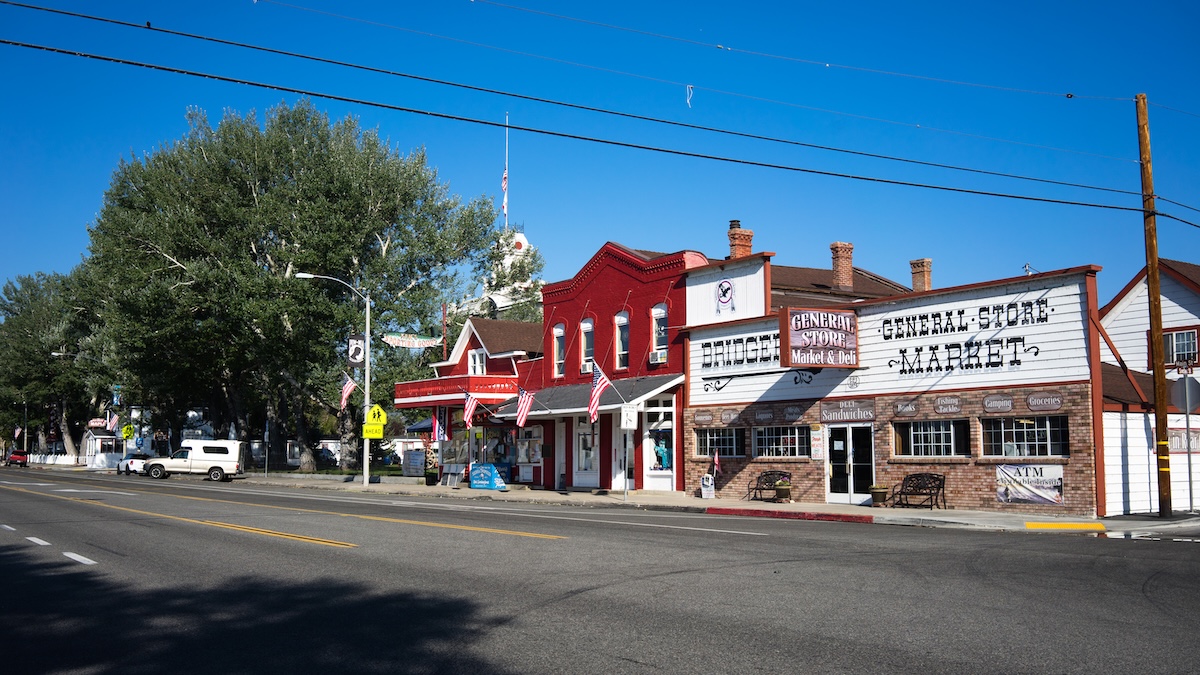The country’s political mood may not reflect it, but the gaping chasm of income inequality in the US actually narrowed, ever so slightly, in the last couple years. Rising wages, pandemic-era government transfers and relatively lower gains among high-income earners, caused the Gini coefficient, a measure of inequality, to register a small drop in 2022, the first decrease since 2007.
But tiny improvements in income are not going to revive economic mobility, restore financial security or create generational wealth for millions of families. Broad wealth-creation requires strategies to give millions more families ownership stakes in assets that appreciate over time, including homes, businesses and financial reserves.
“The ownership economy has arrived,” ImpactAlpha declared this year, as disparate strategies around home ownership, employee ownership, community-owned real estate and individual financial accounts converged to create a new category of ownership investing as “a structural intervention in how assets and returns are distributed,” as Bridgespan’s Devin Murphy puts it.
Crucially, ownership strategies represent a form of predistribution, rather than redistribution, making them a rare area of bipartisan agreement. The ownership narrative flips the script from zero-sum to bigger pie, from scarcity to abundance and from disadvantage and division to “let’s all get richer, together.” As a response to rising economic populism, broad-based ownership strategies offer real results rather than rhetoric and reaction.
Equally important, that appreciation enables private investors to still earn decent returns while sharing the wealth with households that have been largely excluded from it. Driving ownership of real assets – land, homes, businesses, equities – down the quintiles of the country’s wealth pyramid has become a viable, and arguably essential, investment strategy. The key metric: The share of return generating assets distributed to the balance sheets of low-wealth households (see the new report, “Ownership Investing: Financing the Future of Wealth”).
Participants in the Ownership Economy include the millions of workers becoming owners as their baby boomer bosses retire, or first-time home buyers accruing at least fractional stakes through shared-equity schemes. And the Ownership Economy includes the growing number of asset owners backing fund managers with strategies that leverage the manifest advantages of cutting more people in (see ImpactAlpha’s database of more than 65 funds investing in the Ownership Economy).
A few of the storylines we’ll be watching in 2025:
1. Private equity giants share a little bit more with low-income workers
Small ownership stakes that may not pay out for years won’t be enough to deliver the boosts in worker engagement and retention that create business value.
“Awarding ownership shares alone won’t automatically generate returns for investors or upside for employees,” Ellen Frank-Miller of the Workforce and Organizational Research Center, or WORC, wrote in a guest post on ImpactAlpha. To ignite the full benefit and unlock wealth, she says, “broad-based ownership must be tied to a quality jobs strategy.”
According to Harvard Business Review: When at least 30% of the shares are owned by a broad-based group of employees and all employees have access to ownership, companies “are more productive, grow faster and are less likely to go out of business than their counterparts.”
Under the leadership of KKR’s Pete Stavros, more private equity investors are committing to sharing some of their profits with the employees of their portfolio companies. Since Stavros founded the Ownership Works nonprofit in 2021, he has recruited 34 private equity firms with over $1 trillion in assets under management to commit to creating $20 billion in working-class wealth by 2030.
In the shared ownership exits to date, workers have received about 5% of the enterprise value of the companies they work for. That has amounted to roughly $570 million in payouts to a few thousand workers. But just $176 million has been allocated to low- and moderate-income earners; only $143 million has gone to families of color. Ownership Works’ Anna-Lisa Miller told ImpactAlpha the nonprofit is working to broaden shared ownership to more workers of color by expanding the approach to new industries and geographies.
Separately, Blackstone, the world’s largest private equity firm (in total assets under management), this year committed to implementing broad-based employee ownership as part of its US buyout strategy and to fostering more inclusive and vibrant workforces. Rutgers launched the University Consortium on Employee Share Ownership to expand the study and practice of employee share ownership.
As more private equity firms adopt shared ownership strategies, ImpactAlpha will be asking how much they’re sharing with workers relative to how much is going to private equity executives and their investors.
- “As private equity firms start to share the wealth, low-income workers get just a little bit,” by Roodgally Senatus
- “In private equity, pairing employee ownership with good jobs can unlock wealth for all,” by Ellen Frank-Miller
- “Hope Mago: Finding alpha with a ‘gainful jobs’ strategy,” by David Bank
- “Blackstone’s embrace of employee ownership signals a shift in private equity – and in the power of workers,” by Roodgally Senatus
2. Asset owners seek fund managers who see opportunities through ‘an ownership lens.’
A growing number of funds are financing employee ownership transitions in which workers end up with stakes of at least 30% and, over time up to 100%, of the businesses where they work.
Nearly two-dozen such “specialized employee ownership funds” are currently seeking to raise a combined $670 million to provide subordinated, mezzanine and junior debt financing to selling owners, according to “Capitalizing the employee ownership opportunity” from Ownership Capital Lab and Transform Finance. “The field’s impact leaders – funds that prioritize Black, Brown and low- and medium-income workers, utilize durable employee ownership forms and integrate worker voice and/or governance – do not have the capital they need behind them,” the report concludes.
Apis & Heritage Capital Partners has been scooping up employee-led buyout, or ELBO, deals across the US with its $58.1 million inaugural Legacy Fund since 2021. With five out of a target eight to 10 transactions completed, the Washington, DC-based impact investing firm is raising its second Legacy Fund to finance worker-ownership conversions for lower-middle-market businesses with large workforces of color.
“We sometimes say the first generation of wealth should go to the entrepreneur who took the risk and stood the business up, but that the next generation of wealth should go to the folks showing up everyday and driving value to keep the company thriving,” says Michael Brownrigg of Apis & Heritage.
Through an impact buyout strategy and an inclusive ownership accelerator, New Majority Capital is raising a $50 million fund that will cover upfront capital costs for underrepresented entrepreneurs across US cities to acquire small businesses.
Obran Cooperative is raising a $30 million acquisition fund to purchase small and mid-sized impactful and profitable businesses, transitioning them to 100% employee ownership through its worker-owned cooperative structure. “That fund is designed specifically to close the financing gap when it comes to doing the transactions,” says Obran’s Joseph Cureton, who is stepping down as chief coordinating officer. Obran’s Celia Day will take over from Cureton as interim CCO.
Other ownership funds raising capital include Essential Owners Fund, Project Equity’s Employee Ownership Catalyst Fund and Cannabis Employee Ownership Fund. Unlock Ownership Fund is looking to raise an initial $10 million, mainly from capital sitting in tax-advantaged donor-advised funds, to provide grants and other forms of catalytic capital to emerging ownership funds and investment initiatives that target Black and Brown households marginalized communities.
- “Meet 22 funds raising capital to finance high-impact transitions to employee ownership,” by David Bank
- “A primer for investors branching into employee ownership,” by Curt Lyon and Julie Menter.
- “Wanted: First-time fund managers with strategies to ‘Unlock Ownership’ in underserved communities,” by Roodgally Senatus
- “Through small business acquisitions, New Majority aims to create ownership access for underrepresented entrepreneurs,” by Roodgally Senatus
- “Worker-owned ‘conglomerate’ Obran Cooperative gets a boost from Acumen America investment,” by Roodgally Senatus
3. Local and community ownership revive commercial corridors without displacement
In Baltimore, San Antonio and other US cities, developers are using local and community ownership of mixed-use real estate development, homes and businesses to revitalize commercial corridors without fueling displacement and gentrification.
The ‘corridor’ thesis: Local and broad-based ownership of real estate and business assets enables long-time residents to participate in the upswing, without being displaced from their neighborhoods by rising rents and speculative developers.
In San Antonio’s majority-Latino west side, ESTAR West, led by former San Antonio mayor Henry Cisneros, is raising a $25 million real estate fund to acquire mixed-use real estate that create affordable housing for local residents and retail stores for local small business owners.
For his “Real Revitalization” series, ImpactAlpha’s Roodgally Senatus visited three community-led efforts in West Baltimore that are redeveloping blocks of mostly-abandoned and dilapidated rowhomes in the city’s “Black Butterly.” Bree Jones’ Parity is looking to raise up to $5 million in low-interest debt capital to acquire and rehabilitate 20 homes a year in the historically majority-Black middle-class neighborhood of Harlem Park. Her goal is to sell the homes to “legacy residents,” people who once lived in Harlem Park, or whose parents and great grandparents lived there.
On once-bustling West Baltimore Street, Nadine Ngoube Dlodlo’s Women’s Home Preservation is seeking $20 million to finance mixed-use developments that will create affordable housing for single-mothers and widows, and retail and arts and performance spaces for local residents. David Lidz’s WaterBottle is looking to raise and deploy up to $15 million a year in a co-op real estate portfolio that is owned and governed by worker-owners and tenants.
- “Part 1: Parity buys back the block to drive community revival without displacement in West Baltimore,” by Roodgally Senatus
- “Part 2: Worker co-op turns distressed homes in West Baltimore into affordable housing and shared equity,” by Roodgally Senatus
- “Part 3: In Baltimore, Women’s Home Preservation adds clean energy and affordable housing to the community revitalization toolkit,” by Roodgally Senatus
- “Can commercial corridors + broad ownership build community wealth without displacement?” by Roodgally Senatus
4. Shared-equity strategies get another look from first-time home buyers
First-time home buyers are testing new approaches to becoming homeowners as high mortgage rates and soaring housing costs locks them out of the market. They’re trying out strategies that allow them to purchase their homes little by little over time, as well as share the responsibilities of homeownership with institutional investors.
In North Carolina, Ownify is using shared-equity bricks to help first-time homebuyers purchase equity shares of a home via rental payments, via a fractional ownership scheme it is touting as an equitable upgrade from predatory rent-to-own models. The Raleigh-based company is raising a $10 million inaugural fund to pilot the strategy with up to 50 aspiring homeowners in North Carolina’s most populous metropolitan areas.
In Colorado, Homium is piloting a shared-appreciation note that can both provide down-payment assistance to first-time homebuyers and help existing homeowners unlock built-up equity in their homes. The New York-based digital home equity lender is aiming to roll out the product nationally in the new year, through a target $350 million loan fund that will focus on low and middle-income, Black and Brown homeowners and homebuyers.
“We want to put a billion dollars towards homeownership in the next 12 months and we can unblock that billion in home financing with just around $300 million of capital,” says Homium’s David Jette. “With the median home price in the US at $400,000, you’re talking about 2,000 homes, which would make a huge dent, especially in target communities where you’re talking about uplifting families for generations.”
Homium last month appointed Marcus Martin, previously with US Bank, as chief impact officer. Impact investing veteran Anthony Bugg-Levine joined as a senior strategic advisor. “You should expect to see a variety of programs that will come in 2025 that will look at ways in which we can be a superior product or an improvement to some of the current down-payment assistance solutions,” Martin told ImpactAlpha.
- “Ownify seeks to pave a fractional pathway to home ownership, brick by shared-equity brick,” by Roodgally Senatus
- “With shared-appreciation notes, Homium aims to help home buyers overcome the down-payment hurdle,” by Roodgally Senatus
5. With equity and ownership, multi-racial prosperity transcends artificial divisions
OK, let’s acknowledge that this headline remains, uh, aspirational. “It’s clear that impact investing has fallen short of the promise to create substantive change in Black, Brown and modest wealth communities,” the social entrepreneur Napoleon Wallace says in ImpactAlpha’s new mini-documentary, “Equity and Ownership: Napoleon Wallace and the Reconstruction of Black Wealth” (watch the trailer).
The film charts Wallace’s decision to leave his position as North Carolina’s deputy secretary of commerce to build Activest, Partners in Equity, Southern Reconstruction Fund’s Fund ONE and other enterprises that together, he thought, represented a path to racial equity through wealth creation for Black families and communities.
“We’ve been on the long, uphill climb to expand access to the ownership economy to all, and remove the dangerous presuppositions of race, gender and wealth as indicators of entrepreneurial talent,” Wallace told ImpactAlpha through the text-to-voice “eye pad” he uses as he faces the challenges of advanced ALS.
The documentary connects today’s Reconstruction with the remarkable success story of Wilmington, NC’s “fusion” politics of the 1890s, when the city’s majority Black population supported banks, department stores and newspapers before a white supremacist coup in 1898 overthrew the city’s elected government and massacred citizens in the streets (listen to our podcast, “Lessons from the Wilmington coup of 1898”).
On ImpactAlpha’s final Call of the year, Wallace invited Agents of Impact to Durham in 2025 to build out the new model.
“Together, we’ll explore pathways to economic mobility, social justice and political empowerment, building on the powerful legacy of fusion politics.”











